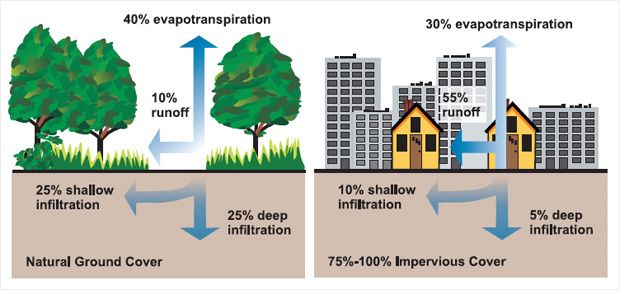Urban Surface Water Management Solutions
Published on by Water Network Research, Official research team of The Water Network in Technology
Alan Wiebe writes about urban surface water management solutions, and why this question is vital both for local governments and urban dwellers.

Surging surface water runoff and ice-plugged culverts resulting in localized urban flooding frustrated local governments and residents over this year’s spring melt.
Water flowing over the concrete landscape of the urban environment also inundated local drainage networks and contributed to rising water levels in response to this year’s unusual freezing and rapid melting temperatures. Heavy equipment urgently worked to clear ice from culverts and ditches as water back flooded over roads and streets of the impervious urban landscape.
The concrete sea of the urban landscape is a vast impermeable surface contributing to tidal flows of water runoff. Water that is unable to soak into the ground will quickly flow over asphalt parking lots, roads, rooftops, driveways, sidewalks, and residential streets into the local drainage network and low-lying areas.
The amount of impervious surface within a watershed determines how great the change in runoff will be. Surface water runoff will double and triple in areas with 10-20% and 30-50% impervious surface cover. The majority of all surface water will result in runoff in urban areas with 75-100% impervious surface cover. This means that the process of urbanization dramatically increases surface water runoff because water is prevented from soaking into the soil.
The increasing frequency and severity of short-duration, high precipitation events are also challenging the way we think about sustainable urban surface water management strategies. Today, we are seeing more severe precipitation events in the amount of rain that falls in a storm – even though annual precipitation events are staying the same. This means that multi-day storms are increasing in frequency and extreme precipitation events are becoming more severe and damaging.
The traditional approach to urban surface water management has been to direct runoff into the urban drainage network. While this approach has been successful at removing water from roads and streams, it has contributed to greater stream bank erosion and sediment transport. Urban streams have subsequently been channelized with concrete to push water through the system more efficiently, resulting in increased downstream flooding in the lowland portions of the watershed. The shift away from traditional urban surface water management practices to more innovative and sustainable approaches are essential for mitigating flood risk and building more resilient communities.
Permeable Paving
Permeable paving refers to paving technologies for porous pavement. The porous material of the pavement allows surface water to seep through the surface into a base layer for on-site storm water infiltration and filtration. Permeable pavement can be utilized for roads, paths, driveways, parking lots, sidewalks, and other surfaces that are subject to light vehicular traffic. They are becoming increasingly popular for reducing runoff in major urban centres because they maintain the functionality of a stable, load-bearing surface. These innovative systems utilize a wide variety of technologies for increasing soil infiltration capacity, including pervious concrete; porous asphalt; plastic grids; permeable interlocking concrete pavers; and resin bound paving made of recycled materials, such as glass, plastic, and rubber. Permeable paving is an effective strategy for low impact development at the neighbourhood scale. This strategy may be incorporated with innovations at the property scale to further enhance the utility of sustainable surface water management initiatives in urban areas.
Rain Gardens
A rain garden is a bowl-shaped perennial garden that captures surface water runoff from hard surfaces. They are planted near drain spouts and sump pump outlets to allow water runoff to absorb into the ground. Rain gardens provide important environmental benefits at the property scale. They improve water quality as surface water filters into the ground. Nutrients in the water are then taken up by native plant species in the garden. Rain gardens also create habitat for birds, bees, butterflies, and other wildlife; they reduce downstream flooding; and beautify your home and neighbourhood. Rain gardens ideal for storing water from parking lots and rooftops by reducing the amount impervious surface cover in urban areas.
Naturalized Storm Water Retentions
Naturalized urban storm water retentions are aesthetically pleasing urban design features, which utilize the ecological functions of wetlands to slow high water flows; reduce surface water runoff from urban and semi-urban areas; and mitigate the effects of downstream flooding. Naturalized wetlands improve water quality as they are vegetated with water loving native plant species. Native plant species contribute to a greater biodiversity in the local area, as well as provide natural habitat to a variety of waterfowl and amphibian species. The native plant species of naturalized systems also provide goose deterrence and management by limiting goose access from the water to grazing areas. Native plant root systems penetrate deep into the ground and clean the water as they absorb nutrients, degrade pesticides, retain sediments, and reduce pathogens as water infiltrates back into the soil for groundwater recharge.
Naturalized urban storm water retentions are a cost-effective alternative to conventional retentions because less soil is removed from a site; rock or soil does not need to be imported to a site; construction time is reduced; basin construction can occur during slower times of the year; maintenance of surrounding native grass uplands is a fraction of the cost of maintaining sod; and there is no maintenance required to remove or manage unwanted algal blooms or submersed vegetation.
Read more: SRRCD
Media
Taxonomy
- Rainwater Harvesting
- Urban Drainage
- Technology
- Scarcity
- Stormwater Management
- Smart City
- Stormwater
- Urban Water
- Urban Resource Management
- Urban Water Supply
- Storm Water Management
- Urban Drainage System
- Urban Water Infrastructure
- Urban Design